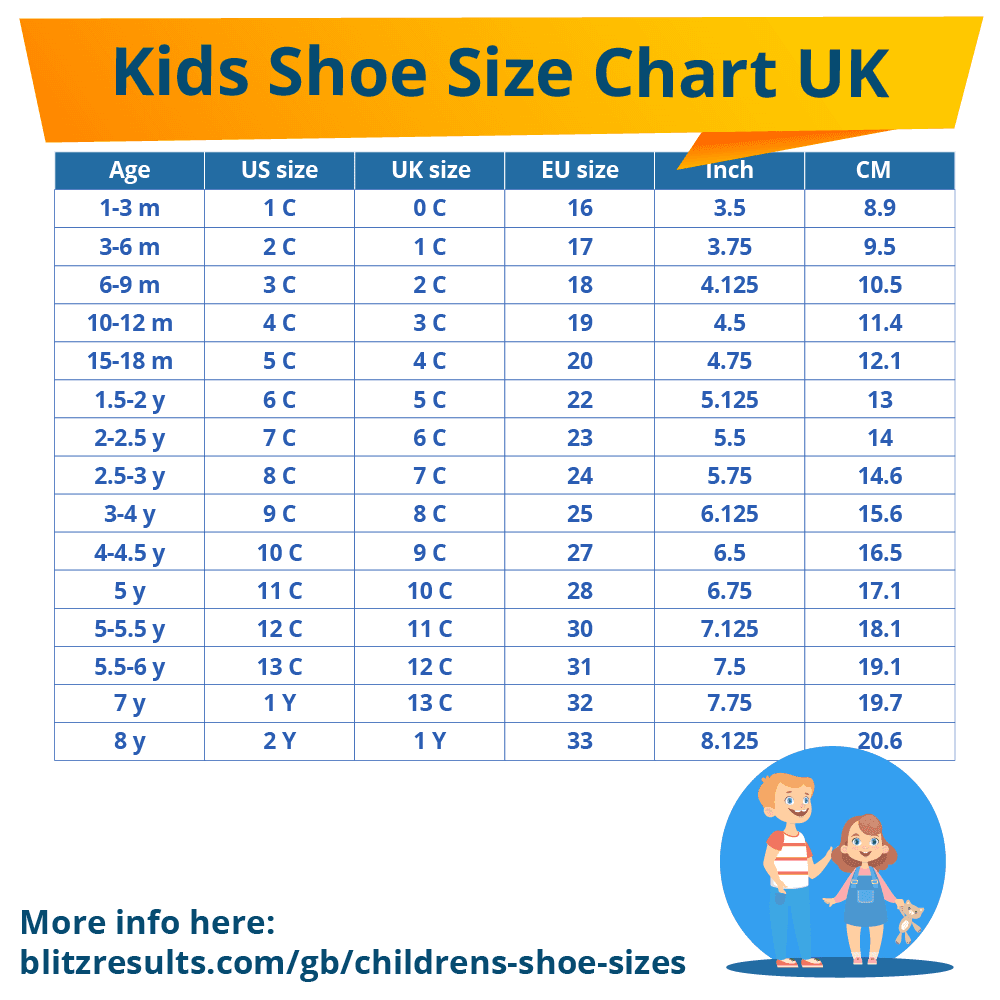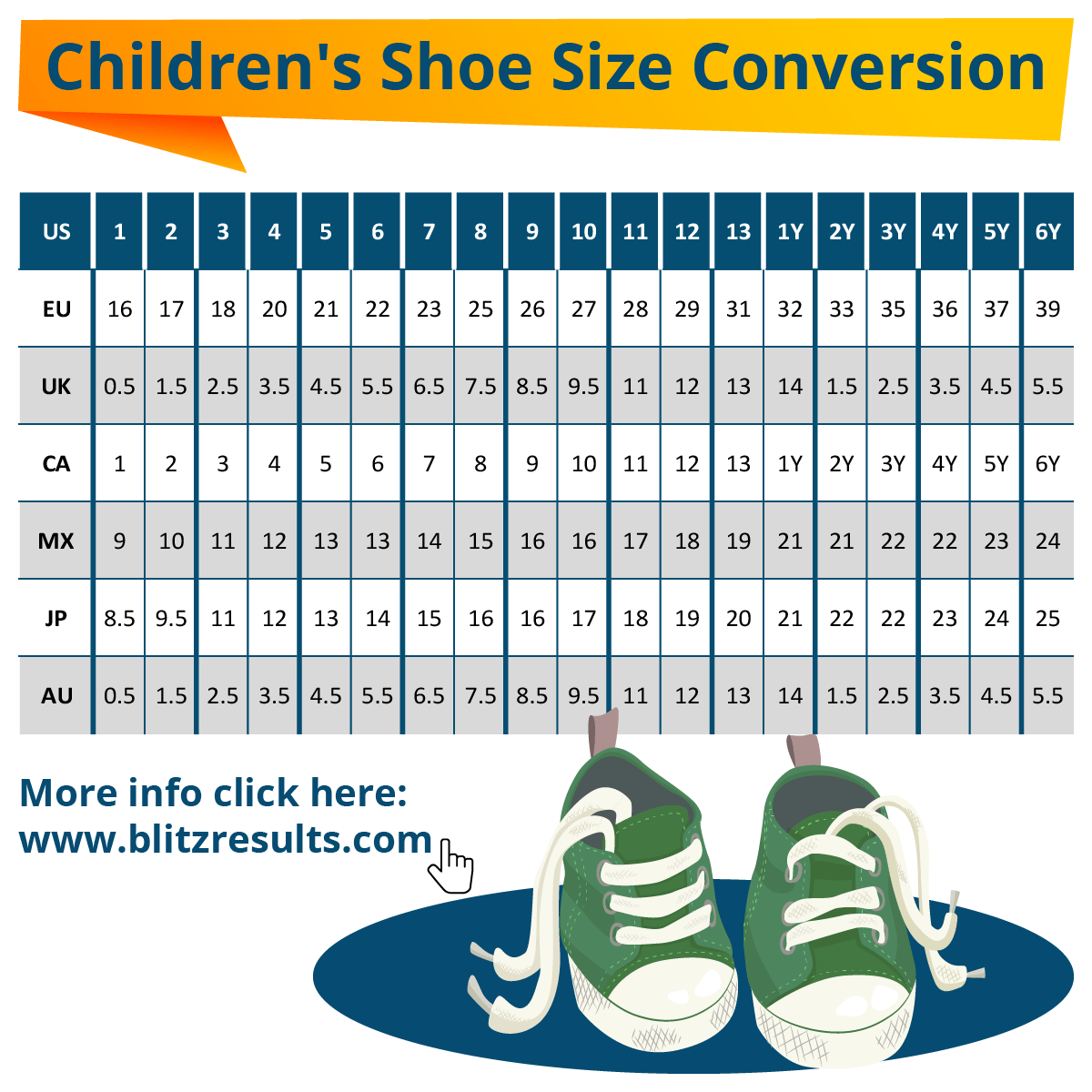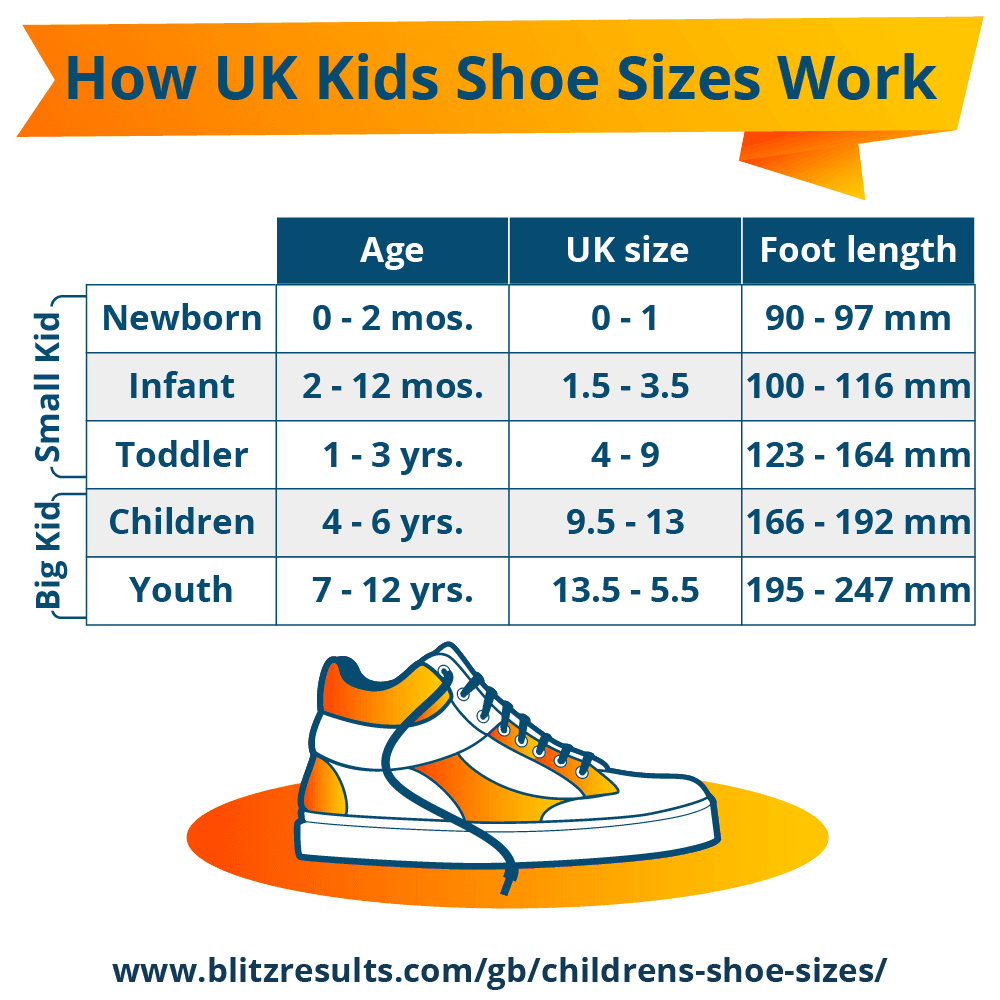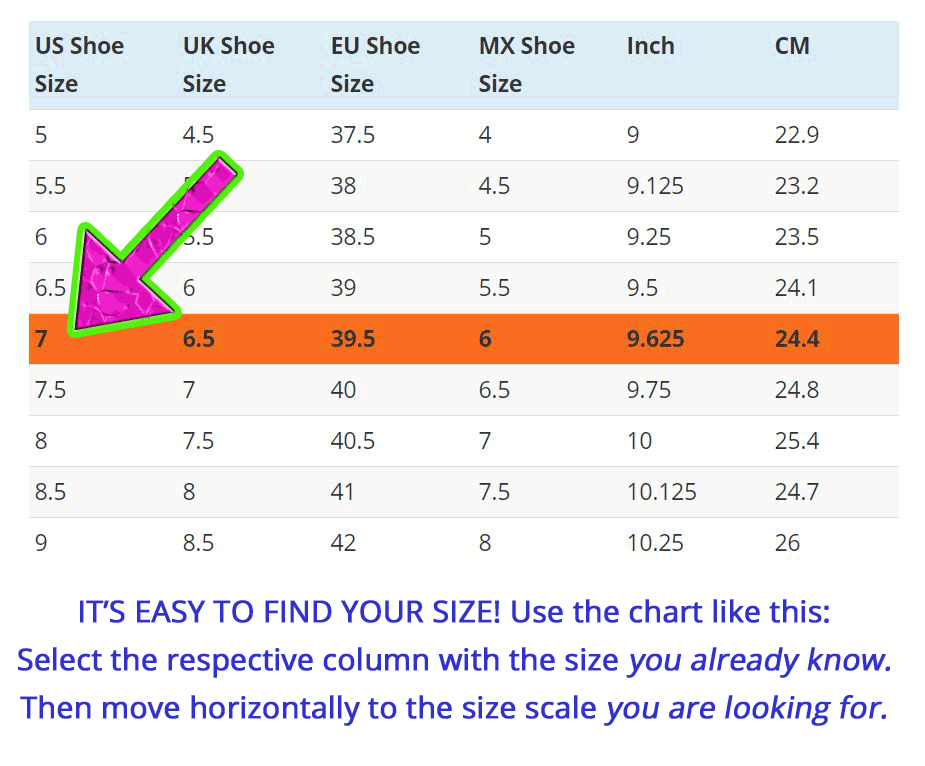Everything you need to find the correct children’s shoe sizes – whether it’s for little ones, older children, or adolescents. Discover the appropriate shoe size effortlessly using our kids shoe size chart UK and convert to international sizes such as US, EU, or Asian sizes.
Remember: Children’s feet can grow incredibly quickly, up to 2–3 centimetres resp. one inch per year (equivalent to two shoe sizes!). Ill-fitting shoes can cause permanent harm to children’s feet. Take your time when purchasing shoes for your child. Have their feet measured regularly and compare the measurements with our UK kids shoe size chart.
Kids Shoe Size Chart UK

It’s easy to find perfectly fitting shoes by using a size guide like our UK kids shoe size chart.
| UK Shoe Size Kids | Foot length Centimetres | Foot length in Inches |
|---|---|---|
| UK 4 | 12.3 cm | 4 7/8" |
| UK 4.5 | 12.7 cm | 5" |
| UK 5 | 13.0 cm | 5 1/8" |
| UK 5.5 | 13.3 cm | 5 1/4" |
| UK 6 | 13.8 cm | 5 1/2" |
| UK 6.5 | 14.2 cm | 5 5/8" |
| UK 7 | 14.6 cm | 5 3/4" |
| UK 7.5 | 15.0 cm | 6" |
| UK 8 | 15.4 cm | 6 1/8" |
| UK 8.5 | 15.7 cm | 6 1/4" |
| UK 9 | 16.0 cm | 6 3/8" |
| UK 9.5 | 16.6 cm | 6 5/8" |
| UK 10 | 16.9 cm | 6 3/4" |
| UK 10.5 | 17.3 cm | 6 7/8" |
| UK 11 | 17.6 cm | 7" |
| UK 11.5 | 17.9 cm | 7 1/8" |
| UK 12 | 18.5 cm | 7 1/4" |
| UK 12.5 | 18.8 cm | 7 3/8" |
| UK 13 | 19.2 cm | 7 1/2" |
Read a kids shoe size chart like this: Select the column with the size you already know. Then move horizontally in the same line to find the size you are looking for. If in doubt, or between sizes, opt for the bigger one!
At a Glance
- Little kid sizes go up to US 13.5C, then big kid/youth sizes start at 1Y.
- UK sizes are about 0.5 smaller than US sizes. There are charts to compare UK, US and EU sizes.
- Key tips: Measure feet regularly as kids’ feet grow rapidly. Allow 0.5-0.75in of room in new shoes. Stick to kids’ sizes as long as possible to save money.
- Find Baby Shoe Sizes UK and Toddler Shoe Size Chart UK here.
Kids Shoe Size UK Conversion to EU & US
If you want to convert EU Shoe SIze to UK Kids, use the chart below.
| UK Shoe Size Kids | US Kids Shoe size | Euro Shoe Size Kids |
|---|---|---|
| UK 4 | US 4.5C | EU 20 |
| UK 4.5 | US 5C | EU 20.5 |
| UK 5 | US 5.5C | EU 21 |
| UK 5.5 | US 6C | EU 21.5 |
| UK 6 | US 6.5C | EU 22.5 |
| UK 6.5 | US 7C | EU 23 |
| UK 7 | US 7.5C | EU 23.5 |
| UK 7.5 | US 8C | EU 24.5 |
| UK 8 | US 8.5C | EU 25 |
| UK 8.5 | US 9C | EU 25.5 |
| UK 9 | US 9.5 | EU 26 |
| UK 9.5 | US 10C | EU 27 |
| UK 10 | US 10.5C | EU 27.5 |
| UK 10.5 | US 11C | EU 28 |
| UK 11 | US 11.5C | EU 28.5 |
| UK 11.5 | US 12C | EU 29 |
| UK 12 | US 12.5C | EU 30 |
| UK 12.5 | US 13C | EU 30.5 |
| UK 13 | US 13.5C | EU 31 |

EU Sizes = European Sizes/Euro Sizes are used in the whole of Europe, including France, Italy, Germany, Sweden etc. Italian Shoe Sizes, French Shoe Sizes and German Shoe Sizes are all unified as “Euro Shoe Sizes”.
International children’s shoe size conversion and EU shoe size to UK children’s: Let’s take a UK shoe size 6, for example. Following this chart, we can see that a UK 6 shoe size is a US size 6.5, which is quite similar. However, it’s a Euro size 23. By measuring your child’s foot and using this chart, you can easily figure out which size is right for them, even when shopping for non-UK shoe sizes.
Youth Shoe Size Chart
| UK Youth Shoe Size | Foot length (millimetres) | Worn by |
|---|---|---|
| 13.5 | 195 | Youth |
| 1 | 200 | Youth |
| 1.5 | 204 | Youth |
| 2 | 210 | Youth |
| 2.5 | 213 | Youth |
| 3 | 217 | Youth |
| 3.5 | 220 | Youth |
| 4 | 226 | Youth |
| 4.5 | 230 | Youth |
| 5 | 236 | Youth |
| 5.5 | 247 | Youth |
Above, we’ve put together a helpful youth shoe size chart which will help you find the right shoe size for big kids. This can also be considered a big kids shoe size chart. We’ve also noted the length of each size in inches to ensure that you can convert any shoe size quickly and easily.
How do UK Shoe Sizes for Kids work?

Understanding Kids’ UK Shoe Sizes: Shoe sizes for kids differ greatly from adult shoe sizes. First, there is no differentiation in gender, meaning that boys and girls use the same size (unlike women’s shoe sizes and men’s shoe sizes which differ greatly). But kid’s shoe sizes are divided into different age groups: Small or Little Kid Shoe Sizes vs. Big Kids/Youth Shoe Sizes. Small kids are newborn, infant and toddlers. Big kids shoe sizes are from size 10C (approx. 4 years) up to size 6Y.
FAQ
EU Shoe Size to UK Kids
Easily convert EU shoe sizes to UK kids’ sizes with our handy conversion chart. Translating children’s shoe sizes from European to UK measurements is quite uncomplicated. Typically, one would deduct 16 to 18 from the EURO size to ascertain the UK equivalent. For example, a European size of 25 would roughly translate to a UK size 8 for children.
Kids Euro Shoe Size to UK
The conversion of Euro to UK shoe sizes for kids is fairly straightforward. As a general rule, you can subtract 16 to 18 from the Euro size to estimate the UK size. For instance, a Euro size 20 would approximately equate to a UK size 4 for children. Check our handy conversion chart.
Is UK Children Shoe Size Same As European?
No. EU size for children’s shoes are not identical to UK sizes – so there is a conversion necessary. Consult with our kids shoe size conversion charts to find the right EU and UK size.
Is UK Kids Shoe Size Same As American (US)?
No. However, they are quite similar. UK’s children’s shoe sizes are, as a rule, 1/2 size smaller than the corresponding US size. A size 8 US shoe is a size UK shoe, and so on. Consult with the above charts and calculators, and you’ll be able to make sure you choose the right US shoe size, based on your UK shoe size.
What is the difference between shoe size 14C and 1Y?
There is not much difference between size 13 kids shoes and 1 adult. In terms of sizing there is only approx. 1/2 inch difference between 14C and 1Y. In the UK, the kids shoe size system switches to the youth respectively men’s shoe size system after size 14 kids shoes. Then it restarts counting at 1(Y).
What is the difference between kids and adult shoe sizes?
Adult sizes start at 7 2⁄3” or 19.5 centimetres (UK size 0). Keep in mind that kids shoes are generally cheaper than adults. Money wise, it could be a good idea to stick to children’s shoe sizes as long as possible.
How much room should children have in a shoe?
Your child’s neon-coloured Adidas or Nike sneakers and sparkly Stride Rite Mary Jane shoes may look snazzy — but do they actually fit?
If your child’s shoes leave less than half an inch (12 mm) of space for the feet, it is time to buy new shoes.
New shoes, on the other hand, should leave at least 3/4 inch (17 mm) of free space for the feet to move.
How to Read a Kids Shoe Size Chart?
Shoe size chart kids can be read as follows: Read a kids shoe size chart like this: Select the column with the size you know, and move horizontally in the same line to find the size you are looking for.
Read a kids shoe size chart like this: Select the column with the size you know, and move horizontally in the same line to find the size you are looking for.
